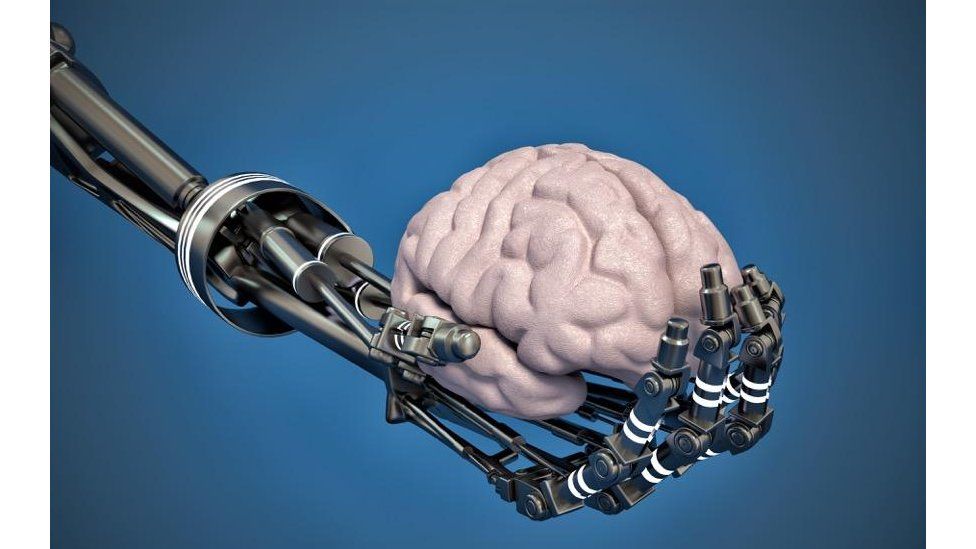Intelligent Machines: The truth behind AI fiction
- Published

Artificial intelligence (AI) is the science of making smart machines, and it has come a long way since the term was coined in the 1950s.
Nowadays, robots work alongside humans in hotels and factories, while driverless cars are being test driven on the roads.
Behind the scenes, AI engines in the form of smart algorithms "work" on stock exchanges, offer up suggestions for books and films on Amazon and Netflix and even write the odd article.
But AI does not have the greatest public image - often due to sci-fi films that display dystopian visions of robots taking over the world.
Over the next week, the BBC will be looking into all aspects of artificial intelligence - from how to build a thinking machine, to the ethics of doing so, to questions about whether an AI can ever be creative. Read more in our Intelligent Machines special report.
For many, the only reference point they have for AI comes from films. So what is the reality of where we are with the technology, and is it anything like the fictional future we have created?
The all-knowing machine
Hal is perhaps the most famous AI turned bad. Created by Arthur C Clarke for the book and film 2001: A Space Odyssey, Hal stands for Heuristically Programmed Algorithmic Computer.
Designed to control the systems of the Discovery One spacecraft, on which much of the film is set, as well as interact with the crew, it quickly starts taking its own course - one that does not involve humans.
Perhaps the closest we currently have to Hal is Watson, IBM's supercomputer, which can understand natural language and read millions of documents in seconds.
In 2011, it beat the world's two best players of the Jeopardy quiz show.
Unlike Hal, it is currently working in harmony with humans, in diverse fields such as the research and development departments of big companies such as Proctor and Gamble and Coca-Cola - helping them find new products.
It is also being used in a dozen US hospitals, helping oncologists find treatments for cancer.
It has even been incorporated into a toy dinosaur, allowing children their first taste of communication with an AI. They can ask the dinosaur questions and Watson will help it answer them.
The killer robot
T-800, the Terminator robot from the films of the same name, has living tissue over a metal endoskeleton and is programmed to kill on behalf of Skynet, an artificially intelligent system that has taken over the world's computers in order to destroy the human race.
No AIs yet being developed have self-awareness and all are programmed to help humankind. The exception to this is military robots, which are increasingly being developed for deployment on battlefields, where their role could be more contentious.
The US military unit Darpa is developing lots of robotic kit, such as exoskeletons to give soldiers superhuman strength and access to visual displays that will help their decision making.
It is also using Atlas robots, developed by Boston Dynamics, intended for search and rescue.
Although there are currently no killer robots, there is a campaign to stop them ever being produced, and the UN has said that no weapon should be operated without human control.
The helpful robot
C-3PO is a humanoid robot from the Star Wars films. He is designed to serve human beings and boasts of being fluent in over six million forms of communication.
His main job is to assist etiquette, customs and translation so that meetings of different cultures run smoothly.
In the real world, companion robots are really starting to take off.
Pepper is a humanoid robot, developed by technology firm SoftBank, that went on sale in Japan this summer and sold out almost immediately.
Its big selling point is that it can supposedly recognise human emotions. So if you look sad when you get home from work, it will suggest that you play some music.
It has learnt about human emotions by watching videos showing facial expressions.
The cleaning robot
Wall-E is a little robot from the Disney film of the same name, left to tidy up after humanity leaves the planet in a mess.
Short for Waste Allocation Loader Lift Earth-Class, Wall-E is the ultimate in loveable machines.
Although not as cute as Wall-E, vacuums programmed to clean up are probably the first example of domestic learning robots.
The company iRobot makes the best-known brand, the Roomba, which, as of February 2014, had sold more than 10 million units. It automatically guides itself around home via onboard sensors which also detect obstacles. At the end of cleaning it takes itself back to its docking station to charge.
Anecdotal evidence suggests some people become as attached to them as pets and take them on holiday.
The human-looking robot
Ava - the lifelike android from 2015 science fiction film Ex-Machina, is the ultimate in AIs.
Able to conduct a conversation on any topic, show empathy with humans and look entirely human herself, she also has her own agenda, and it is one that does not involve humans.
This type of AI is the one that people fear the most, and while the cleverness of Ava is very far from being achieved, a few people have experimenting with creating robots that look entirely human.
Robotic engineer Hiroshi Ishiguro made a robotic copy of himself, dubbed Geminoid, to study human-robot interaction.
He used silicon rubber to represent skin - but cosmetic company L'Oreal recently teamed up with bio-engineering start-up Organovo to 3D print human skin, potentially making even more lifelike androids possible.
Prof Chetan Dube, chief executive of software firm IPsoft, has developed a virtual assistant called Amelia, and he firmly believes robotics and AI are about to come together.
He believes Amelia will be given human form indistinguishable from the real thing at some point this decade.
- Published13 February 2014
- Published29 July 2015